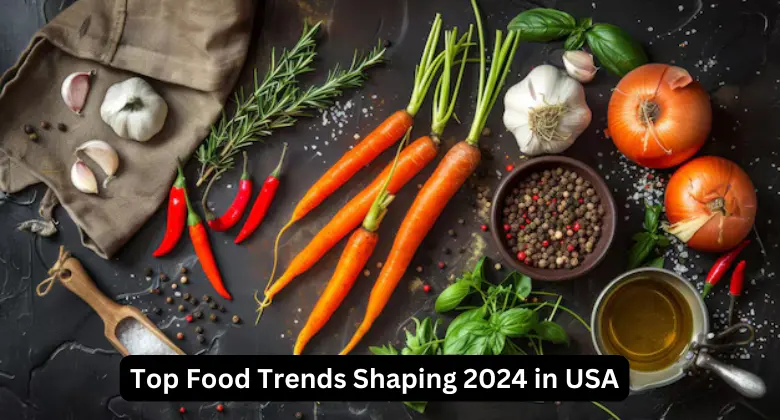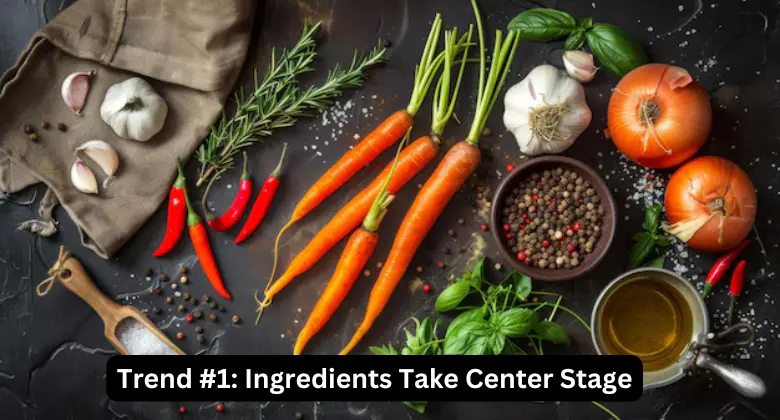Top Food Trends Shaping 2024 in USA
As the global food and beverage industry evolves, consumer preferences and environmental considerations continue to shape the market landscape. This year, our extensive research has revealed ten impactful trends that will dominate 2024, each with unique implications for consumers and brands. Let’s dive into these trends and explore how they are transforming the industry.


Trend #1: Ingredients Take Center Stage
Consumers are paying closer attention to what goes into their food, with a third of them actively inspecting product labels for key ingredients. Among these, protein reigns supreme, prioritized by 42% of global consumers. This shift encourages brands to highlight “hero” ingredients with storytelling, artistic visuals, and transparent sourcing narratives.
Examples of Ingredients in Focus
| Ingredient | Popular Format | Consumer Appeal |
|---|---|---|
| Almond flour | Gluten-free baked goods | Natural, minimally processed |
| Pasture-raised eggs | Dairy alternatives | Ethical, sustainable sourcing |
Brands embracing ingredient transparency are not only catering to curiosity but also building trust through clear and visually engaging labeling.
Trend #2: Nurturing Nature
Sustainability is evolving beyond reducing harm to making a positive environmental impact. Consumers increasingly expect companies to adopt proactive measures such as nature protection and sustainable resource use.
Key statistics:
- 37% increase in products with forest protection claims (2020-2023)
- 40% rise in water-usage claims during the same period
Agrobiodiversity is a growing focus, as diversified farming ensures food security and planetary health. Companies like Bayer are exploring crop gene editing to tackle climate challenges and promote eco-friendly practices.
Trend #3: Prioritizing Prevention
The emphasis on proactive health is redefining consumer choices. Over one-third of consumers prioritize prevention strategies such as weight management, heart health, and bone health. Products like Beeza Peanut Butter, which claims to support weight and heart health, are gaining traction.
This trend also aligns with healthy aging, with balanced diets and weight management identified as vital steps by consumers worldwide. Companies that address these specific concerns can foster strong loyalty among health-conscious demographics.
Trend #4: Plant-Based Innovations
Plant-based products are shifting from novelty items to mainstream staples by integrating into familiar formats like finger foods and ready-made meals. Over half of global consumers value familiarity when exploring plant-based options.
Popular plant-based formats:
- Finger foods: A gateway for plant-based meat and poultry alternatives
- Ready-made meals: Convenient and approachable for broader demographics
The rising appeal of plant-based offerings reflects changing dietary preferences and the demand for versatile, sustainable food choices.
Trend #5: Local Ingredients, Global Appeal
The dual appeal of local sourcing and global cuisine continues to expand. Two-thirds of consumers are open to exploring foreign dishes, with African and East Asian cuisines experiencing notable growth (13% and 5%, respectively, over five years).
Simultaneously, consumers value local ingredients, associating them with transparency and authenticity. Brands emphasizing their regional roots and genuine ingredients can attract ethically minded and adventurous eaters.
Trend #6: Home Kitchen Renaissance
With shifting lifestyles and tighter budgets, the home is becoming a hub for culinary exploration. Nearly 43% of consumers report eating more at home over the past year, while only 15% ate out more frequently.
Key drivers:
- Value for money: Affordable meal preparation
- Health benefits: Greater control over nutritional content
Home cooking also fosters experimentation, with 60% of consumers stating they are most adventurous with flavors in their kitchens. This trend signals opportunities for brands to offer innovative, easy-to-use cooking aids.
Trend #7: Health Meets Indulgence
The blurring lines between indulgence and health continue to shape product offerings. More than half of global consumers are willing to trade some indulgence for healthier options, spurring the rise of indulgent products with active health claims.
Recent innovations:
- Loacker Quadratini Wafers: Reduced sugar, added chicory root fiber
- Joya Chocolate: Stress resistance and immune function claims
This trend challenges brands to balance taste, texture, and health benefits without diluting the essence of indulgence.
Trend #8: Oceans as a Resource
The potential of the seas as a source of sustainable nutrition is becoming increasingly apparent. Ingredients like kelp and spirulina are gaining momentum, with microalgae-based product launches growing by 42% from 2020 to 2023.
Sustainability in seafood is also gaining recognition. Certifications like MSC and Friend of the Sea ensure consumers can make informed, eco-friendly choices. Ocean-derived innovations signal an exciting frontier for sustainable food development.
Trend #9: Hydration Reimagined
The hydration market is bubbling with innovation, blending health benefits and advanced technology. Products boasting electrolytes, alkaline properties, and ultra-purification are setting new benchmarks.
Hydration Product Features
| Feature | Example Claim |
|---|---|
| pH-balanced | Alkaline water (pH 9.5) |
| Functional benefits | Skin health, stress resistance |
Functional hydration products like Core Hydration+ exemplify how brands are carving niche categories by addressing unique consumer needs.
Trend #10: Simplifying the Experience
In an era of information overload, straightforward communication resonates with consumers. Simplified packaging that clearly conveys brand values, shelf life, and sustainability claims helps build trust.
A growing concern among consumers is greenwashing, with half of them struggling to identify deceptive sustainability claims. Transparent communication, backed by verifiable certifications, can mitigate this issue and foster credibility.
Looking Ahead: How Brands Can Adapt
As these trends evolve, brands must remain agile to stay ahead. For instance:
- In “Ingredients Take Center Stage,” shifting consumer preferences could propel lesser-known ingredients into the spotlight.
- “Prioritizing Prevention” may diversify as different demographics seek tailored health benefits.
- “Health Meets Indulgence” could face limits in balancing indulgence with healthfulness without compromising taste.
By proactively embracing these trends, brands can resonate with consumer values while paving the way for innovation and sustainability.
